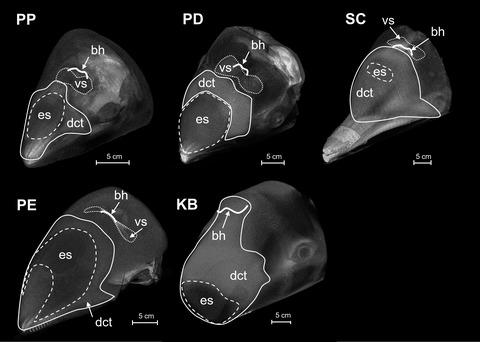当前位置:
X-MOL 学术
›
Mammal Rev.
›
论文详情
Our official English website, www.x-mol.net, welcomes your
feedback! (Note: you will need to create a separate account there.)
Determinants of echolocation click frequency characteristics in small toothed whales: recent advances from anatomical information
Mammal Review ( IF 4.3 ) Pub Date : 2020-09-10 , DOI: 10.1111/mam.12212 Mika Kuroda 1 , Nobuhiro Miki 2 , Takashi Fritz Matsuishi 1
中文翻译:

小齿鲸的回声定位点击频率特性的决定因素:解剖学信息的最新进展
更新日期:2020-09-30
Mammal Review ( IF 4.3 ) Pub Date : 2020-09-10 , DOI: 10.1111/mam.12212 Mika Kuroda 1 , Nobuhiro Miki 2 , Takashi Fritz Matsuishi 1
Affiliation

|
- The pulse‐like clicking sounds made by odontocetes for echolocation (biosonar) can be roughly classified by their frequency characteristics into narrow‐band high‐frequency (NBHF) clicks with a sharp peak at around 130 kHz and wide‐band (WB) clicks with a moderate peak at 30–100 kHz. Structural differences in the sound‐producing organs between NBHF species and WB species have not been comprehensively discussed, nor has the formation of NBHF and WB clicks.
- A review of the sound‐producing organs, including the latest findings, could lead to a new hypothesis about the sound production mechanisms. In the current review, data on echolocation click characteristics and on the anatomical structure of the sound‐producing organs were compared in 33 species (14 NBHF species and 19 WB species).
- We review interspecific information on the characteristics of click frequencies and data from computed tomography scans and morphology of the sound‐producing organs, accumulated in conventional studies. The morphology of several characteristic structures, such as the melon, the dense connective tissue over the melon (the ‘porpoise capsule’), and the vestibular sacs, was compared interspecifically.
- Interspecific comparisons suggest that the presence or absence of the porpoise capsule is unlikely to affect echolocation frequency. Folded structures in the vestibular sacs, features that have been overlooked until now, are present in most species with NBHF sound production and not in WB species; the vestibular sacs are therefore likely to be important in determining echolocation click frequency characteristics. The acoustical properties of the shape of the melon and vestibular sacs are important topics for future investigations about the relationship between anatomical structure and sound‐producing mechanisms for echolocation clicks.
中文翻译:

小齿鲸的回声定位点击频率特性的决定因素:解剖学信息的最新进展
- 齿形棘突回声定位(生物声纳)产生的脉冲状咔嗒声可通过其频率特性粗略分类为窄带高频(NBHF)咔嗒声,其峰值大约在130 kHz,而宽带(WB)咔嗒声则为在30–100 kHz处有一个中等的峰值。尚未全面讨论NBHF物种和WB物种之间发声器官的结构差异,NBHF和WB喀哒声的形成也没有得到全面讨论。
- 对声音产生器官的回顾,包括最新发现,可能会导致关于声音产生机理的新假设。在当前的审查中,比较了33个物种(14个NBHF物种和19个WB物种)的回声定位点击特性数据和发声器官的解剖结构数据。
- 我们回顾了传统研究中积累的有关点击频率特征的种间信息以及计算机断层扫描和发声器官形态的数据。种间比较了几种特征结构的形态,例如瓜,瓜上的致密结缔组织(“海豚囊”)和前庭囊。
- 种间比较表明,海豚胶囊的存在与否不大可能影响回声定位频率。前庭囊的折叠结构是迄今为止被忽视的特征,在大多数产生NBHF声音的物种中存在,而在WB物种中则没有。因此,前庭囊可能在确定回声定位点击频率特性方面很重要。瓜类和前庭囊的形状的声学特性是未来研究回声定位咔嗒声的解剖结构与发声机制之间关系的重要主题。











































 京公网安备 11010802027423号
京公网安备 11010802027423号